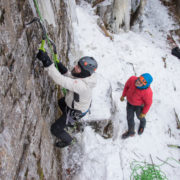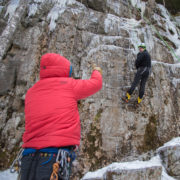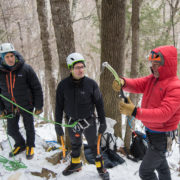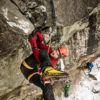Ethics for Climbing Rock with Ice Tools – “Dry Tooling”
Mainstream mixed climbing is here. How do we protect the climbs for future generations?

Peter Doucette shakes out and searches for the next edge, divot or dimple towards progress on this attempt of Cryokinesis. Photo: Ray Rice
THINK before you climb rock with ice tools. The marks you make will last many lifetimes
We have to be careful. Dry tooling causes damage to the rock. With time, the damage dry tooling causes becomes tolerated, accepted, and sanctioned by some. This will ultimately destroy a rock climb and the experience for future generations of climbers.
It’s real simple. Be respectful of the rock and it’s environment. Think about future climbers. Keep your impact to a minimum. Leave as little trace as possible and remember, cumulative damage is always the problem.
Some recent posts from Facebook on Dry Tooling.
~Thanks Janet for motivating me to do this post. We need this awareness.
Janet B. Wilkinson
February 11 at 9:06pm ·
I really wish people wouldn’t dry tool and dry crampon rock routes on Cathedral (or at least wouldn’t post photos here or elsewhere of it). That includes Diedre. There, I said it.
Richard Parker
Indeed, in the 90’s we saw significant rock damage at Rumney from picks and crampons…those scars are (almost) forever!
Nick Yardley
Some thoughts from the Lake District, basically if it’s a popular rock route it’s worth more as such to the general community.
Bruce Adams
Dry tooling should just go away.
Alden Pellett
Janet, even worse is the damn rock climbers thinking they own the cliff and bolting up sport routes where runout winter mixed routes were put up first!
Michael Wejchert
Yes! Diedre is climbable as an ice route when it’s in; you don’t have to touch rock on the 5.10 pitch when properly formed. Thinking it’s ok to dry tool when it’s bare rock isn’t so hot. I know it’s a weird trip down ethics lane for visiting climbers, but consider: if there’s no ice on a pitch, you’re ruining a classic rock route for future aspiring leaders.
There are no hard and fast answers. But here are a few questions that need to be answered
- Where do aspiring climbers practice their craft?
- What is considered unacceptable?
- What are the ethos to preserve the climbing experience for future generations?
- Can popular rock climbs and dry tooling coexist?
- How do we deal with excessive traffic on popular climbs
-Where do aspiring climbers practice their craft of dry tooling?
Dry tooling should be practiced in areas not good for rock climbing and not on established rock climbs.
Train and refine your skills on artificial walls.
Find areas where rock climbers never go.
Most climbing areas now have designated cliffs where dry tooling is accepted. Find out where they are.
Go to alpine areas for the best training.
Seek out advice and guidance from professional climbing guides.
Ryan Stefiuk guides participants in mixed climbing techniques at the Mt. Washington Valley Ice Fest. Photos: Courtney Ley
-What is considered unacceptable?
Dry tooling on popular and classic rock climbs with no ice.
Scratching your way up a climb. If you are inexperienced and at your limit, think about leaving it for another day. Strong and skilled climbers can often do a climb leaving hardly a mark.
Not asking for local information on what is acceptable and where to go. What’s acceptable at one cliff is completely off limits at another. Educate yourself in the local ways.
-What are the ethos to preserve climbs for future generations?
Think about the damage you may do to the rock if you climb it with ice tools.
Think about the cumulative effect of many climbers over time.
Think about future generations, and how you might change their experience of the climb.
Have the common sense to move on when conditions are not right for a non-destructive assent.
Be careful when rappelling. Crampons scratch the rock more during rappels than during ascents.
Mixed climbers need to think about their actions to prevent future access problems.
-Can popular rock climbs and dry tooling coexist?
NO!
The universal consensus is that no popular, established rock climb should be dry tooled.
If it’s a popular rock route, it’s worth more to the climbing community as a rock climb, than as a dry tool climb.
Guidebook authors need to include dry tooling areas, information and local ethics. Don Mellor, author of Blue Lines 2: An Adirondack Ice Climber’s Guide, says, “While I have no interest in or right to tell others what to do in their recreation time, as a guidebook writer I do not want to be complicit in encouraging people to scar rock with ice gear.”
Popular rock routes have been climbed in winter for years, but not with the frequency we have today. We must be aware of the cumulative damage we are causing and take action to prevent it.
-How do we deal with excessive traffic on popular climbs?
We need to generate public knowledge and awareness of the problem.
We need leaders in the community to promote good dry tooling ethics.
We need to be specific with what climbs are acceptable to dry tool in a given area and ones that are forbidden.
Posting less on social media about sensitive climbs will help keep the traffic down.
Posting more on social media about good dry tooling ethics and setting good examples is the right thing to do.
When you are out climbing, think about the damage you may cause before you climb rock with ice tools. Most often, you have two choices. Do, or try the climb, no matter the condition or what your impact might be. Or you can be thoughtful, respectful, and considerate of others, the environment and the future. Make the right choose for the environment and others. Our climbs and climbing areas are a finite resource that we need to protect!
~Doug Millen
More on Dry Tooling
The Access Fund – (pdf) MIXED EMOTIONS: THE IMPACTS AND IMPLICATIONS OF DRY-TOOLING
Sources: Facebook, The Access Fund, Blue Lines,







So, if dry, tooling destroys the rock, how about erosion the rock where I live changes so fast, I doubt it matters
Just wanted to drop a note here for ice climbers looking for a good training solution. Furnace industries has several variations of ice climbing tools that are made out of wood and rubber, they are essentially like rock climbing shoes on wouldn’t scar the rock. It’s true that you will have to sacrifice precision, but it seems like a good compromise.